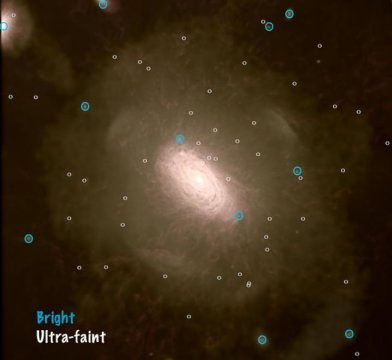[ad_1]
Astronomers from the Institute for Computational Cosmology at Durham University and the Harvard-Smithsonian Center for Astrophysics, have found evidence that the faintest satellite galaxies orbiting our own Milky Way galaxy are amongst the very first galaxies that formed in our Universe.
Scientists working on this research have described the finding as “hugely exciting” explaining that that finding some of the Universe’s earliest galaxies orbiting the Milky Way is “equivalent to finding the remains of the first humans that inhabited the Earth.”
The research group’s findings suggest that galaxies including Segue-1, Bootes I, Tucana II and Ursa Major I are in fact some of the first galaxies ever formed, thought to be over 13 billion years old.
When the Universe was about 380,000 years old, the very first atoms formed. These were hydrogen atoms, the simplest element in the periodic table. These atoms collected into clouds and began to cool gradually and settle into the small clumps or “halos” of dark matter that emerged from the Big Bang.
This cooling phase, known as the “Cosmic dark ages,” lasted about 100 million years. Eventually, the gas that had cooled inside the halos became unstable and began to form stars — these objects are the very first galaxies ever to have formed.
With the formation of the first galaxies, the Universe burst into light, bringing the cosmic dark ages to an end.
Dr Sownak Bose, at Harvard-Smithsonian Center for Astrophysics, working with Dr Alis Deason and Professor Carlos Frenk at Durham University’s ICC, identified two populations of satellite galaxies orbiting the Milky Way.
The first was a very faint population consisting of the galaxies that formed during the “cosmic dark ages.” The second was a slightly brighter population consisting of galaxies that formed hundreds of millions of years later, once the hydrogen that had been ionized by the intense ultraviolet radiation emitted by the first stars was able to cool into more massive dark matter halos.
Remarkably, the team found that a model of galaxy formation that they had developed previously agreed perfectly with the data, allowing them to infer the formation times of the satellite galaxies.
Their findings are published in the Astrophysical Journal.
Professor Carlos Frenk, Director of Durham University’s Institute for Computational Cosmology, said: “Finding some of the very first galaxies that formed in our Universe orbiting in the Milky Way’s own backyard is the astronomical equivalent of finding the remains of the first humans that inhabited the Earth. It is hugely exciting.
“Our finding supports the current model for the evolution of our Universe, the ‘Lambda-cold-dark-matter model’ in which the elementary particles that make up the dark matter drive cosmic evolution.”
The intense ultraviolet radiation emitted by the first galaxies destroyed the remaining hydrogen atoms by ionizing them (knocking out their electrons), making it difficult for this gas to cool and form new stars.
The process of galaxy formation ground to a halt and no new galaxies were able to form for the next billion years or so.
Eventually, the halos of dark matter became so massive that even ionized gas was able to cool. Galaxy formation resumed, culminating in the formation of spectacular bright galaxies like our own Milky Way.
Dr Sownak Bose, who was a PhD student at the ICC when this work began and is now a research fellow at the Harvard-Smithsonian Center for Astrophysics, said: “A nice aspect of this work is that it highlights the complementarity between the predictions of a theoretical model and real data.
“A decade ago, the faintest galaxies in the vicinity of the Milky Way would have gone under the radar. With the increasing sensitivity of present and future galaxy censuses, a whole new trove of the tiniest galaxies has come into the light, allowing us to test theoretical models in new regimes.”
Dr Alis Deason, who is a Royal Society University Research Fellow at the ICC, Durham University, said: “This is a wonderful example of how observations of the tiniest dwarf galaxies residing in our own Milky Way can be used to learn about the early Universe.”
Dr Bose is supported through an Institute for Theory and Computation fellowship at Harvard University, whilst Dr Deason is supported by a Royal Society University Research Fellowship. Professor Carlos Frenk and Dr Deason are both supported by the Science and Technology Facilities Council Consolidated Grant for Astronomy and Durham University.
[ad_2]















